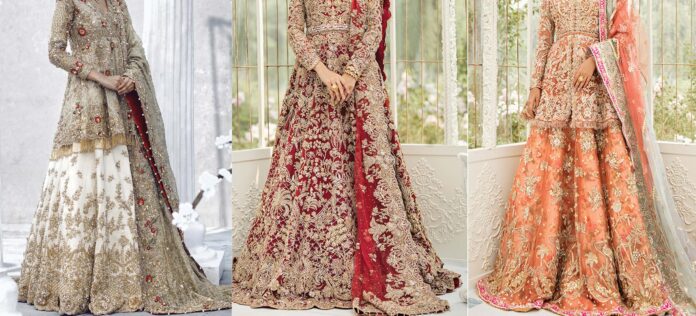On February 4, 2021, a rather peculiar crime took place in Karachi. At the posh locality of Defence on Khayaban-e-Bukhari, a group of robbers made their way to a boutique. As they entered, they did not make a beeline for the cash register and nor did they go looking for precious jewelry. Instead, their focus was on rounding up as many designer bridal dresses as possible.
By the time the robber left the store, they had managed to carry out 98 bridal dresses between them. The total value of the robbery? Rs 1.5 crores. And to anyone surprised either by the nature of the crime or by the value of the stolen dresses – this is not the first time it is happening and it has happened before exactly because people know how expensive these dresses are. A similar incident took place a few months ago in which a boutique in Karachi’s Bahadurabad area was robbed for both cash and dresses.
What do these incidents tell you? There is the obvious, which is that Karachi is not safe and the crime rate is high. It might also tell you that boutiques do not have great security, perhaps because they do not necessarily feel like they are very obvious targets for thieves and robbers. But the most important takeaway from these incidents is that bridal dresses are valuable and worth a lot of money, and their being stolen means there is probably a black market for these stolen dresses.
The thieves in this equation are clearly the criminals. But ostentatious charges for wedding dresses is a practice found everywhere. In Pakistan, it has reared its ugly head more recently in the form of designer dresses with each designer commanding a certain level of prestige and the more the prestige the more ridiculous the prices for these clothes. And while Karachi’s putrid security standards have a lot to do with all of this, it is worth looking into the bridal dresses industry in Karachi and the country at large, and what the dynamics behind these very high end and very expensive products are.
A love for weddings (sort of)
Pakistanis and their love for weddings is no secret. Whether you’re a girl or a boy, once you’re of age your not-so-friendly distant relative starts getting concerned about when you’re tying the knot. While finding a good match is important, the right dress is too. A common question that brides are often asked is “who are you wearing?” No, they aren’t skinning anyone and wearing them, (even though sometimes it feels the designers are when they demand money but more on that later) instead this question means what brand are you going to wear.

This was not always the case. For the longest time, bridal dresses in Pakistani and subcontinental weddings were not the showcase. The culture, however, has long been the same of a wedding being a display of wealth rather than a celebration. Before, it used to be gold sets that were the focus of attention and dresses were usually made through private tailors. However, in the 1990s, Pakistan’s nascent fashion industry began to take shape.
Brands like Gul Ahmed for regular lawn clothes had existed since as early as the 1950s and even before partition, but driven by women entering the workforce in large numbers and having more spending power, a fresh batch of fashion designers cropped up in the late 1990s and early 2000s. Once they established themselves, they also started making wedding clothes and charging high prices for them. In recent years, with more designers coming in and social media making wedding pictures and captions on those pictures particularly important, the significance of the wedding dress in Pakistani weddings has increased. With news like Isha Ambani’s wedding lehenga costing 90 crores going viral in the Pakistani social media sae, the prices of wedding dresses are something Pakistanis have become obsessed with and have very much made a status symbol of.
So, if you are a bride deciding on her wedding dress, and your family is the sort that cares about ‘log kya kahen gai’ and putting on display wealth, you would want to go to the top designers that charge the most for often gaudy looking dresses. If you are less ostentatious, but still want a nice designer dress for one of the most important days of your life, you might go for a designer that is not considered top of the line. To figure out who these designers are and what they are charging, we have broken down the industry into six tiers and pricing groups. They are as follows. The content in this publication is expensive to produce. But unlike other journalistic outfits, business publications have to cover the very organizations that directly give them advertisements. Hence, this large source of revenue, which is the lifeblood of other media houses, is severely compromised on account of Profit’s no-compromise policy when it comes to our reporting. No wonder, Profit has lost multiple ad deals, worth tens of millions of rupees, due to stories that held big businesses to account. Hence, for our work to continue unfettered, it must be supported by discerning readers who know the value of quality business journalism, not just for the economy but for the society as a whole.To read the full article, subscribe and support independent business journalism in Pakistan



























Unfortunately, we are good back to mughals and thats by all mean is our destruction .
I was told by one designer to delay the suit for one year, if u want to wear us.
God help Pakistan.Nothing will change.
Analysis is good
Clearly the bridal dress are part of undocumented economy with no eagerness of the designer to formalize there finances.
u NEED TO WORK SMART AS U R WORKING AS journalist by profession. u just took a good move but every one knows most of the brands running by the families of the politicians thats y they evade tax and do not legislate to matter in NA. evry poor is paying tax. same is the case with marble industry no tax formula has been made to collect tax just they are paying the tolls on road thats it rest all is PROFIT!